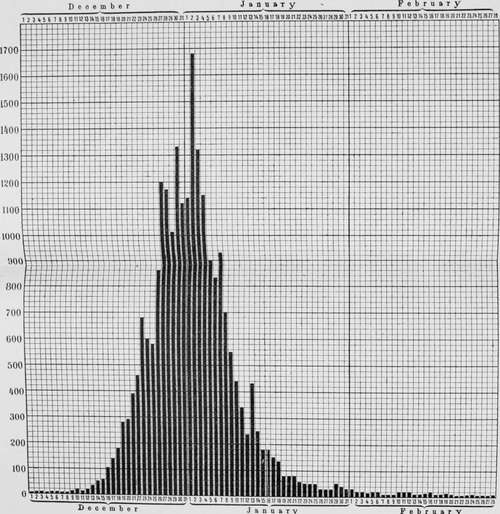Beginning, Acme, And End Of The Epidemic
Description
This section is from the book "Malaria, Influenza And Dengue", by Julius Mennaberg and O. Leichtenstern. Also available from Amazon: Malaria, influenza and dengue.
Beginning, Acme, And End Of The Epidemic
There is no infectious disease which, wherever it breaks out, in so short a time causes such universal infection as influenza. This epidemiologic peculiarity of the pestilence produces an enormous disturbance in trade and traffic, which was well seen everywhere in various degrees during our last pandemic, and of which striking examples are recorded by the historians of earlier epidemics.
There is no doubt that the " suddenness of the universal infection" which furnished the chief reason for believing in the miasmatic nature of the contagion, has been greatly exaggerated. Gradually proofs accumulated, especially from the smaller, more easily supervised cities, that isolated cases, gradually increasing in number, were the precursors of the actual epidemic. The first implanted seeds were frequently overlooked, considered as simple coryza or catarrhal fever, and only retrospectively diagnosed and classified after the outbreak of the pestilence.
The following rules are deduced from the enormous amount of material in reference to the beginning, acme, and end of the epidemic, collected from the innumerable localities affected in Germany, England, Sweden, and Switzerland (Parsons, P. Friedrich, Rahts, Lin roth, H. Schmidt). We are considering pandemic influenza only.
From the date of the first cases until the time of the epidemic frequency-we call this the period of invasion-an average of fourteen days elapses. From this time onward the epidemic develops rapidly, attaining its acme in fourteen days, or at the longest in three weeks, and then comes, as a rule, quickly to an end in a further period of fourteen days to three weeks.
It follows, therefore, that the duration of the actual epidemic period is from four to six weeks, and if we add to this the period of invasion, a total duration of the epidemic of from six to eight weeks.
After the epidemic follow the "trailers," in gradually diminishing number.
An excellent example of this behavior is found in the influenza epidemic of 1889 and 1890 in Munich, in which place, of all German cities, the most exact morbidity statistics were kept (by the adoption of compulsory notification). We would refer our readers to the graphic representation of the periodic course of this epidemic on Plate VIII., which faces this page. It is taken from the treatise of P. Friedrich. Similar instructive curves are found in the articles by Leichtenstern, Parsons, and Ripperger.
PLATE VIII.

Chart showing the daily report of influenza cases in Munich during the months of December, January, and February, 1889-90.
All the earlier pandemics, so far as is known, followed the above mentioned law. This was verified in 1889 in all countries outside of Europe; thus the duration of the epidemic of Massachusetts (Abbott's Collective Investigation) was seven weeks; in Australia, eight weeks; in St. Johns (Newfoundland), six weeks, etc.
The reasons for this regular behavior on the part of the pandemic will be found below. Here it need only be emphasized that the sudden disappearance of the pandemic is only a natural consequence of the rapid universal infection, which in a short time produces immunity among the inhabitants. We must also take into account the fact that the germs, after they have passed through innumerable generations, lose a great part of their virulence and contagiousness.
Continue to:
- prev: Spread Of The Pandemic Of 1889 And 1890 Around The World
- Table of Contents
- next: Epidemics Following The Pandemic
Tags
mosquito, malaria, influenza, dengue, symptoms, outbreaks, diseases, hemoglobinuria, infections
